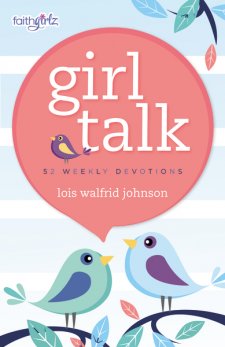
Lois Walfrid Johnson
Zonderkidz
Published May 4, 2010

Amazon | Barnes & Noble | Goodreads
A while back I reviewed a girls’ bible study that left me disappointed—both in the appropriateness of the subject matter for the age group and in some of the teaching. Since then I’ve been on the hunt for a devotional or study that my eleven-year-old and I could do together, something that addresses some of the issues she faces on a daily and weekly basis.
Girl Talk is set up in chapters, one for each week. Each chapter begins with a story in which the main character faces an obstacle or choice. Sometimes the story ends with the dilemma unsolved, and the questions instruct the reader to share what she thinks should happen next and why. Other times the character makes a choice (good or bad) and the reader is asked to evaluate the outcome.
The issues raised definitely fall within the kinds of things my daughter and I frequently discuss. The girls in the stories face issues with friends at school or bullying. They struggle with family situations and challenges with parents or siblings.
Each Girl Talk story is followed by a series of discussion questions meant to be tackled over each day through the rest of the week. The chapters begin with a scripture that addresses a key issue from the story and end with a written prayer also relating to the topic from the chapter.
If you do the devotional this way, it should only take a few minutes to read the story and answer a question on each day. If you wanted to use the book for a more concentrated study, I think it would make a great source for a weekly meeting, as the questions all relate to each other and gradually lead to a conclusion.
Overall, I’m pretty happy with this book, and I’ve already talked to my daughter about doing the lessons together. She’s really excited. The only thing I can think to say that I wish was done differently was the fact that culturally it felt very bland. I think it could have been cool to see more of an ethnic feel and some diversity to the characters featured in the stories. Other than that, I loved it and definitely recommend it to girls looking for gentle but grounded, practical devotions.
Cultural Elements
A few of the girls featured have ethnic names. One is Chinese, a couple are Spanish. Beyond this, the stories read pretty generically in terms of race or culture. It would have been cool to see them infused with a more diverse feel. I recognize they’re really short stories, and there’s not a lot of time for developing setting and character, but I think it could have had more of a diverse feel than it did.
Profanity/Crude Language Content
None.
Romance/Sexual Content
None.
Spiritual Content
See review. The devotional explores real life situations and girls who want to behave in a manner consistent with Christian values. The lessons instruct girls using Bible verses and prayer.
Violent Content
None.
Drug Content
In one of the stories, a girl’s mother drinks too much and neglects her younger sister.